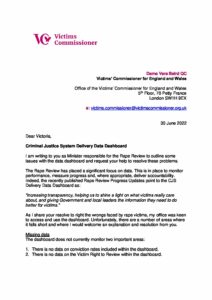Letter to Victoria Atkins MP on Criminal Justice System Delivery Dashboard
Letter to Victoria Atkins - Data Dashboard (PDF, 146.8 KB)
Writing to the Justice Minister Victoria Atkins MP, the Victims’ Commissioner outlines shortfalls with the rape review progress update data dashboard, including missing data and presentational and transparency issues.
- Following the resignation of Victoria Atkins MP on 6 July 2022, Tom Pursglove MP was appointed Minister with responsibility for the end-to-end rape review. Dame Vera wrote to Tom Pursglove MP on this matter on 28 July 2022.
30 June 2022
Dear Victoria,
Criminal Justice System Delivery Data Dashboard
I am writing to you as Minister responsible for the Rape Review to outline some issues with the data dashboard and request your help to resolve these problems.
The Rape Review has placed a significant focus on data. This is in place to monitor performance, measure progress and, where appropriate, deliver accountability. Indeed, the recently published Rape Review Progress Updates point to the CJS Delivery Data Dashboard as:
“increasing transparency, helping us to shine a light on what victims really care about, and giving Government and local leaders the information they need to do better for victims.”
As I share your resolve to right the wrongs faced by rape victims, my office was keen to access and use the dashboard. Unfortunately, there are a number of areas where it falls short and where I would welcome an explanation and resolution from you.
Missing data
The dashboard does not currently monitor two important areas:
- There is no data on conviction rates included within the dashboard.
- There is no data on the Victim Right to Review within the dashboard.
Your foreword to the Rape Review Progress Update rightly focusses on conviction rates. However, the dashboard does not include data on this area. This is a clear measure of justice for victims and the dashboard is incomplete without it.
The Victim Right to Review (VRR) is another important measure for transparency. Measuring the number of VRRs, proportion that are successful and the proportion that go on to secure a conviction is an important metric to understand the health of the criminal justice system and victims’ ability to challenge it.
I urge you to add these metrics to the dashboard in order to deliver the transparency it seeks to provide and which it is unable to do so without this data.
Challenges with the dashboard
My team have also identified a number of practical issues which we’d welcome your explanation and resolution of, namely:
The three main metrics in the dashboard (number of suspects referred by police to the CPS, number of suspects authorised to be charged and number of receipts at Crown Court) are only presented as absolute numbers rather than proportion of cases. As the number of recorded rapes has increased by c20,000 cases since 2016, we would expect these numbers to increase without a proportional improvement across all victims. In order to provide full transparency and accountability, the dashboard should also present this data, and comparison to the 2016 benchmark, as a proportion of all victims. Taken together, these will provide a wider and balanced measure of progress following the Rape Review.
The data in the dashboard cannot always be reconciled to the data source they have used. In some cases, (for example, pre-charge receipts) my team have found that this data is published by other sources, in this case the CPS. However, the dashboard currently states that “this metric is not published outside of this dashboard” and the two sets of data cannot be reconciled. This mismatched duplication of figures is confusing and risks undermining confidence in the dashboard, particularly so when the source of the data in the dashboard is not cited. There are further similar examples. This makes monitoring the data impossible and undermines its legitimacy. It is important that the data in the dashboard has a cited source and any discrepancies from other published data are either resolved or fully explained.
Finally, many of the links to data sources included in the dashboard simply do not work. This, again, risks transparency and confidence in the dashboard and undermines the effort and work that has gone into develop this accountability tool. It is fundamental to be able to cite a source for data and transparency simply cannot be delivered without it. I would welcome a review of the dashboard to ensure that these links are functional.
I welcome your resolution to make progress on this key area of work and applaud the move to publish data as a means for public accountability. There is real potential for accountability if the dashboard is presented effectively. I therefore welcome your intervention and help to resolve these problems and ensure that the tool delivers robust data, that stands up to scrutiny and that victims and their advocates can have confidence in.
It is my normal practice, in the interests of transparency, to publish my correspondence with ministers.
Kind regards,
Dame Vera Baird QC
Victims’ Commissioner for England and Wales

